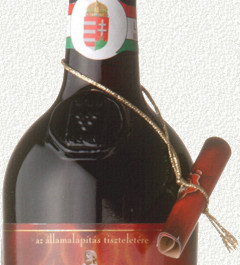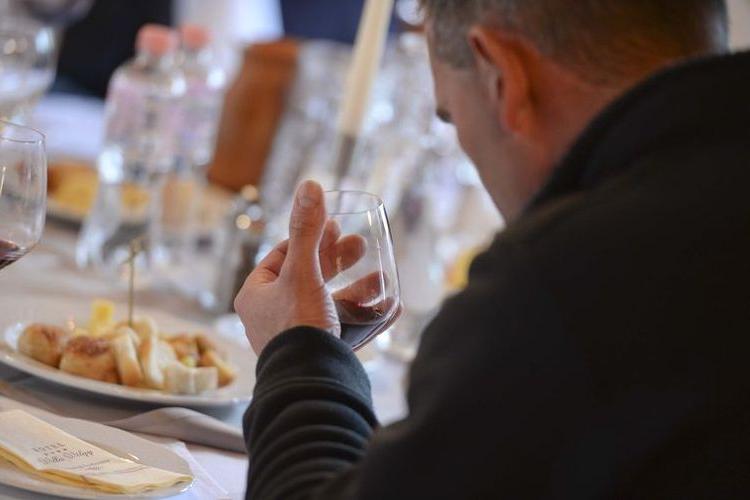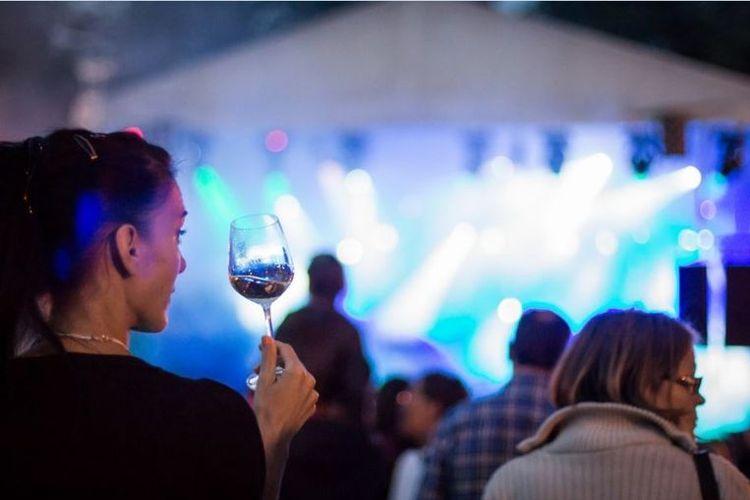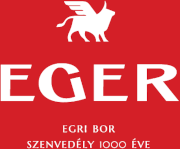
THE EGER WINE REGION
The some 5400 hectares of vineyards of the Eger wine region is located on the southern slopes of the Bükk Mountains . The wine region is divided into two districts of protected origins: the Eger and the Debrő districts, thus embracing the town of Eger and the following 19 villages: Andornaktálya, Demjén, Egerbakta, Egerszalók, Egerszólát, Felsőtárkány, Kerecsend, Maklár, Nagytálya, Noszvaj, Novaj, Ostoros and Szomolya in the Eger, and Aldebrő, Feldebrő, Tófalu, Verpelét, Kompolt and Tarnaszentmária in the Debrő district.
THE CENTRE OF THE WINE REGION: EGER
The City of Eger, this town of over a thousand years, with its glorious historical past, valuable historical building complexes, wines and curative waters is one of the most famous cities of Hungary. Eger is usually called a historical city and also the city of the Baroque, the city of wine, the city of curative and thermal waters and the city of students. It was a bishop's seat as early as during the reign of our first king, Szent István. The town was not spared by the storms of history: it was almost destroyed during the Tartar invasion but its stone fortress built in the 12 th century already played a very important role in the defence of the town during the Turkish battles. In 1552, the captain of the fort, Dobó István, and his 2,000-strong army, just a handful of soldiers - withstood the attack of the 40-times stronger Turkish army for over a month. Eger is the city of the Baroque, its cityscape is dominated by the Baroque. In the 17 th century, it was a significant centre of culture and education. Close to 170 outstanding creations of the architecture of past centuries survived in almost untouched beauty: the castle and its system of fortification, the castle museum, the casemates, the museum of stonework, the Gothic Palace, the Lyceum, the Library of the Diocese, the Specula Obscura (the Observatory), the periscope, the Bishop's Palace, part of the city wall and the bastion, the Turkish Bath, the building of the County Hall with the iron gates wrought by Fazola Henrik, the former County Jail, the Church of the Brothers of Mercy with the hospital, the Cistertian and Jesuit secondary grammar schools, the Foglárium (jail), the Orthodox parsonage and church, the Rococo Small Provost's palace, the Basilica, the Baroque Cistertian, Minorite and Franciscan churches, the Servita church, the Minaret, the Grand Provost's palace, the Centre of the Bishop's Collection, the Telekessy István Apothecary Museum with habán dishes, the Gárdonyi Géza Memorial Museum in the residential building of the writer.
The town and its surroundings are a famous historical wine region. The residents have been involved in grape and wine production for almost a thousand years, producing such excellent wines as Egri Bikavér, Egri Leányka, Debrői Hárslevelű, Egri Chardonnay, Egri Cabernet Franc and Sauvignon, Egri Merlot, Egri Kékfrankos and Kékmedoc. After the change of regime, the Eger wine region went through an extraordinarily fast development. Through the re-planting of the traditional and new types in the best production areas, the area of the vine-lands has grown significantly (Nagy-Eged, Pajdos). The AOC system operating in developed, western wine-cultures has been adopted. In addition to the one large state winemaking company, through the establishment and spectacular development of several hundred medium- and small-sized wine-companies, the quality of the wines of the wine region has improved significantly. Though the age of the oldest wine cellars is over 400 years, new cellars are still being cut even nowadays. We can say with good grounds that EGER IS THE BASTION OF WINES .
C LIMATE
: a characteristic feature of the climate is that spring comes relatively late and the climate is of a dry nature .
SOIL
Black coloured riolite, formed on the hill-sides and hill-slopes, mostly on Miocene-age riolite tufa, as well as clay slate and riolite, poor in lime, brown soils, clay-infused soil, brown forest soils, etc.
HISTORY
The 30-million year old petrifaction of the leaf of Vitis Hungarica was found in the side of the Kis-Eged Hill. This, of course, has not much to do with present-day grape-production.
Eger has been populated since the 10 th century and must have been a significant-sized settlement as early as the beginning of the 11 th century. One of the first bishoprics was founded in Eger by our king Szent István. The monks moving to the bishopric also brought along from their countries the grape types indigenous there.
The Tartar invasion decimated the population. King Béla IV settled Walloons here as well, who introduced their knowledge of grape production and wine-making (e.g. the use of barrels).
The clearings of the slopes around Eger were planted with grapes in the 13 th and 14 th centuries. The Cistertian monks moving in used these grapes to satisfy their demand for wine.
The role of the town in the first centuries of the Hungarian Middle Ages was truly significant: one of the largest bishoprics had its seat in the castle, to which not only Heves County but the whole north-eastern part of the country belonged. The initiation and development of wine-growing can be put down to the central, managing role of the church as wine is an indispensable element of church ceremonies. By virtue of the king's decree, tenths, tithe had to be paid to the church and worldly institutions from wine-growing. The first cellars were built to store the tithe.
Serbs fleeing from the Turks brought along the technology of fermentation sur marc, red wine making and the Kadarka type as well.
After decades of unsuccessful sieges, the Turks took the Eger castle in 1596 and held it for 91 years. In spite of this, grape production survived. The reason for this is that though the Turks themselves did not consume wine, it was a significant source of income.
In the 17 th century, red wine grape types were gaining more and more grounds at the expense of white wine grapes. In 1687, the castle was taken back from the Turks. During the course of the rapid population of the town and its surroundings, the grape mono-culture was established in two decades. Most of the presently used names of the grape hills were formed at the end of the 17 th century and in the 18 th century.
In 1886, phylloxera appeared in Eger , wiping out the grapes almost completely. During the course of re-planting (reconstruction), new types were also introduced to the wine region. Following this, the tendency is similar to that of other wine regions.
Upon the re-planting of the vineyards completely wiped out, the intention was to also adopt types not known earlier. In the past decade, Eger winemakers proved abroad as well that the juice of the Leányka , Királyleányka , Hárslevelű , Olaszrizling , Muskotály , Tramini , Szürkebarát and Chardonnay grapes grown here withstands competition with any domestic or foreign competitor. According to experts, the wines of the Eger Kékfrankos , Blauburger , Merlot , Cabernet Sauvignon , Cabernet Franc and Pinot Noir grapes can also expect great international success if the possibilities of this region are utilised well by the winemakers. Egervin Rt. maintains a stock of museum-quality wines; they provided the space for the creation of the Ezredforduló Egri Bikavére (the Eger Bikavér of the Turn of the Millennium) , which was composed from the wines of one hundred nineteen producers of the wine region. Thummerer Cellar is located only a few kilometres from Eger , in Noszvaj . (The lovely little village located in the embrace of forests, hills and slopes would be worth discovering even if it did not have wines.) Vincze Béla, Eger winemaker, burst into the general knowledge with huge success, making such red wines in his first year with which he achieved Hungarian successes at the international competition organised in Bordeaux (Blaye-Bourg) not seen before. In 1998, Gál Tibor, Eger winemaker, won the title "Winemaker of the Year". The domestic and international successes of Gál Tibor put the wine region as well into the limelight more and more. Szőlészeti és Borászati Kutatóintézet (the Grape and Wine Research Institute), operating in Eger, has achieved great results in the areas of the purification of resistant grapes by breeding as well as in the research on the impact of barrique barrels on wine. The recognition of the Eger wine region is also expressed by the fact that the former maker of Bátaapáti Kastélyborok (Bátaapáti Castle Wines), Dr. Pók Tamás, has appeared in the market with his own Eger cellar and wines made with excellent taste, under the name of Pók Polonyi Pince, as well as Varsányi Pincészet, operating in Verpelét, producing Debrői Hárslevelű, the wine of the district, with great expertise. The spiciness, fieriness and relatively high acid contents of Eger red wines is characteristic mostly of Bikavér. This is why the local winemakers try to put most of their energy into composing Bikavér. By building on the centuries' old traditions, Eger Város Hegyközsége (the Wine-Community of the City of Eger ) included the method of the preparation of this noble drink in the so-named "Bikavér Codex" in 1997.
TIPS FOR TASTING
We can taste excellent Bikavér in the cellars of Bakondi Endre, Kőporos Borászat, Ostoros-Novaj Bor Zrt., Simon József, Tóth Ferenc, Tóth István, Sike Tamás, St. Andrea Borászat, Demeter Pincészet, Juhászvin Kft., Kutató Intézet, Vincze Béla and Egervin Zrt.
The popular scene of wine-related merrymaking and wine tourism is Szépasszonyvölgy with its numerous cellars carved in riolite tufa, and czardas. "Istenes Pince", the oldest, protected monument cellar of the wine region, can be found in the northern branch of the valley, which served as a secret church in Turkish times. We can still see the altar, carved from one piece of stone and the relief work depicting Jesus on the cross. Guests can choose from among dishes composed for Eger wines in more and more restaurants of the area. One of the appetizing dishes is steamed venison chop flavoured with the spices of forests and meadows, served with Bikavér cranberry sauce. We can wholeheartedly recommend to lovers of sweets the Eger ball pancake, inspired by the heroic women of Eger : the dessert flavoured with nut cream and vanilla sauce, together with a glass of museum-quality sweet Egri Leányka is the popular treat of tourists. The two-hundred year old István Pince, owned by Hotel Korona, and the National Wine Museum , the collection of which gives a comprehensive picture of the wines of Hungary , are especially noteworthy.
The area of Eger provides a home and a living for a number of excellent winemakers. Outstanding among these are Thummerer Vilmos, Gál Tibor and Vincze Béla. Thummerer Vilmos, elected the Winemaker of the Year in 1995, makes his high-quality wines in Noszvaj. The Hungarian Wine Academy awarded the honourable title of Winemaker of the Year to Gál Tibor in 1998 and Vincze Béla in 2005 in recognition of their work.
Some pieces of advice for the wine-loving tourist visiting the Eger wine region: after the compulsory sights, marvel at the various kinds of wine cellars carved in riolite tufa, housed by the Kis- and Nagykőporos, Kőlyuk and Verőszala rows of cellars. When you are finished with all this, visit Szépasszony-völgy ( Szépasszony Valley ), look for an ambient wine tavern and enjoy the elegance and special aroma of Eger wines.






